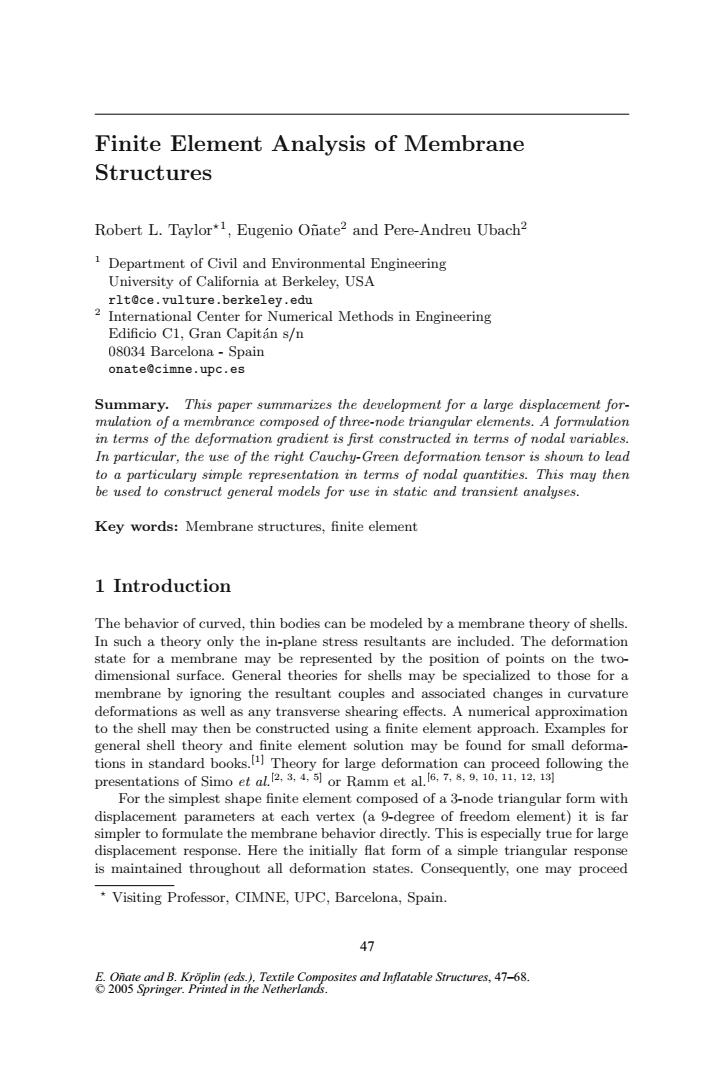正在加载图片...

Finite Element Analysis of Membrane Structures Robert L.Taylor*1,Eugenio Onate2 and Pere-Andreu Ubach2 1 Department of Civil and Environmental Engineering University of California at Berkeley,USA rltOce.vulture.berkeley.edu 2 International Center for Numerical Methods in Engineering Edificio C1,Gran Capitan s/n 08034 Barcelona-Spain onate@cimne.upc.es Summary.This paper summarizes the development for a large displacement for- mulation of a membrance composed of three-node triangular elements.A formulation in terms of the deformation gradient is first constructed in terms of nodal variables. In particular,the use of the right Cauchy-Green deformation tensor is shown to lead to a particulary simple representation in terms of nodal quantities.This may then be used to construct general models for use in static and transient analyses. Key words:Membrane structures,finite element 1 Introduction The behavior of curved,thin bodies can be modeled by a membrane theory of shells. In such a theory only the in-plane stress resultants are included.The deformation state for a membrane may be represented by the position of points on the two- dimensional surface.General theories for shells may be specialized to those for a membrane by ignoring the resultant couples and associated changes in curvature deformations as well as any transverse shearing effects.A numerical approximation to the shell may then be constructed using a finite element approach.Examples for general shell theory and finite element solution may be found for small deforma- tions in standard books.]Theory for large deformation can proceed following the presentations of Simo et al.23.4.5]or Ramm et al.6.7.8.9.10.11,12.13 For the simplest shape finite element composed of a 3-node triangular form with displacement parameters at each vertex (a 9-degree of freedom element)it is far simpler to formulate the membrane behavior directly.This is especially true for large displacement response.Here the initially flat form of a simple triangular response is maintained throughout all deformation states.Consequently,one may proceed Visiting Professor,CIMNE,UPC,Barcelona,Spain. 47 E.Onate and B.Kroplin (eds.).Textile Composites and Inflatable Structures,47-68. 2005 Springer.Printed in the Netherlands.Finite Element Analysis of Membrane Structures Robert L. Taylor1, Eugenio O˜nate2 and Pere-Andreu Ubach2 1 Department of Civil and Environmental Engineering University of California at Berkeley, USA rlt@ce.vulture.berkeley.edu 2 International Center for Numerical Methods in Engineering Edificio C1, Gran Capit´an s/n 08034 Barcelona - Spain onate@cimne.upc.es Summary. This paper summarizes the development for a large displacement formulation of a membrance composed of three-node triangular elements. A formulation in terms of the deformation gradient is first constructed in terms of nodal variables. In particular, the use of the right Cauchy-Green deformation tensor is shown to lead to a particulary simple representation in terms of nodal quantities. This may then be used to construct general models for use in static and transient analyses. Key words: Membrane structures, finite element 1 Introduction The behavior of curved, thin bodies can be modeled by a membrane theory of shells. In such a theory only the in-plane stress resultants are included. The deformation state for a membrane may be represented by the position of points on the twodimensional surface. General theories for shells may be specialized to those for a membrane by ignoring the resultant couples and associated changes in curvature deformations as well as any transverse shearing effects. A numerical approximation to the shell may then be constructed using a finite element approach. Examples for general shell theory and finite element solution may be found for small deformations in standard books.[1] Theory for large deformation can proceed following the presentations of Simo et al. [2, 3, 4, 5] or Ramm et al. [6, 7, 8, 9, 10, 11, 12, 13] For the simplest shape finite element composed of a 3-node triangular form with displacement parameters at each vertex (a 9-degree of freedom element) it is far simpler to formulate the membrane behavior directly. This is especially true for large displacement response. Here the initially flat form of a simple triangular response is maintained throughout all deformation states. Consequently, one may proceed Visiting Professor, CIMNE, UPC, Barcelona, Spain. 47 E. Oñate and B. Kröplin (eds.), Textile Composites and Inflatable Structures, 47–68. © 2005 Springer. Printed in the Netherlands